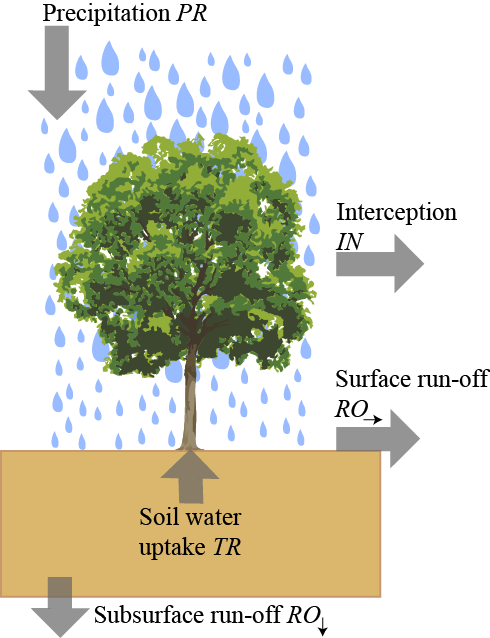COMPETITION AND ENVIRONMENTAL LIMITATIONS
Light is driving factor for tree growth in FORMIND.
As explained in the growth section, incoming light is dependent on the height of all individual trees and the distribution of leaves. Tall trees absorb most of the incoming radiation and with decreasing height from the canopy down to the ground, less radiation is available. With less light an individual tree’s photosynthetic production (GPP) is reduced and tree growth is hindered.
Water Cycle and Soil Water Limitations
Individual trees take up soil water to fulfill the requirements for photosynthesis in the canopy. Instead of modelling the roots of the trees explicitly we determine an uptake of soil water, using the water-use efficiency (WUE) concept. The soil water content is calculated using precipitation, interception of water by stem and leaves, surface run-off and subsurface run-off.
If soil water content is low, photosynthesis is reduced.

Water enters the ecosystem through precipitation e.g. by including climatic precipitation data. Climatic data is input in FORMIND with a “climate file”, which contains daily local information on precipitation, temperature, irradiance, day length, and potential evapotranspiration. This approach allows us to simulate changes in the precipitation pattern caused by, for example, climate change.
Further, several soil parameters are defined, such as permanent wilting point, porosity, fully saturated conductivity, field capacity, soil depth, among others. These allow for a more precise simulation of soil-water-plant interactions for different soil types.
The temperature module
The productivity of a tree may be influenced by phenology (esp. in the temperate zone) and air temperature, which is also included in the climate file. We assume an air temperature range in which maximal photosynthesis is possible. Outside the range, when temperature is high or low, photosynthesis is limited by a reducing factor.
Also, the maintenance respiration might be affected by air temperature. On warm days we assume a higher maintenance respiration than on colder days.
